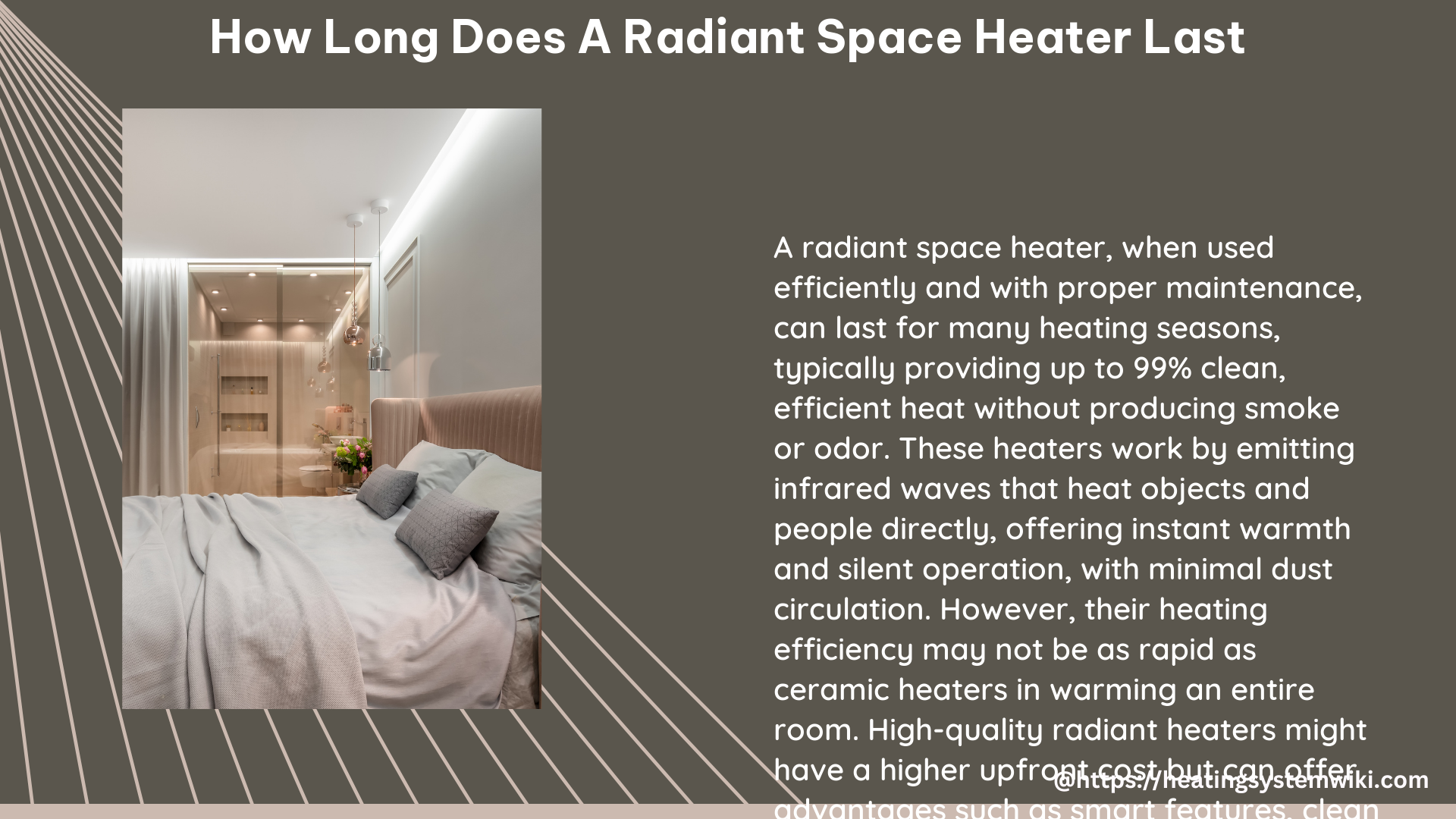A radiant space heater can last anywhere from 10 to 40 years, depending on the type of heater and the quality of its components. Electric radiant heaters, such as those using cables or mats, can last up to 30-40 years, while hydronic radiant heaters can last between 30-50 years. However, the boiler and pump in hydronic systems typically have a shorter lifespan, with boilers lasting 15-20 years and pumps failing after ten years.
Understanding the Lifespan of Radiant Space Heaters
Electric Radiant Heaters
Electric radiant heaters, which use heating cables or mats, are known for their durability and long lifespan. These systems can last up to 30-40 years, provided they are properly maintained and any issues are addressed promptly.
The key factors that contribute to the longevity of electric radiant heaters include:
-
Heating Element Quality: The quality of the heating cables or mats used in the system plays a significant role in its lifespan. High-quality, well-insulated heating elements can withstand the wear and tear of continuous use for decades.
-
Thermostat and Control System: The electronic components, such as the thermostat and control system, are critical to the heater’s performance and longevity. Regularly checking and replacing these components as needed can extend the overall lifespan of the system.
-
Installation and Maintenance: Proper installation and regular maintenance, such as cleaning the heating elements and checking for any damage, can significantly impact the heater’s lifespan. Neglecting maintenance can lead to premature failure of the system.
Hydronic Radiant Heaters
Hydronic radiant heaters, which use flexible “PEX” tubes beneath the flooring, can have an even longer lifespan than electric systems, typically lasting between 30-50 years.
The factors that contribute to the longevity of hydronic radiant heaters include:
-
Tubing Material: The PEX tubing used in hydronic systems is highly durable and resistant to corrosion, which helps extend the system’s lifespan.
-
Boiler and Pump Lifespan: While the hydronic tubing can last for decades, the boiler and pump in the system have a shorter lifespan, typically 15-20 years for the boiler and 10 years for the pump. Regular maintenance and timely replacement of these components are crucial to maintaining the overall system’s longevity.
-
Installation and Insulation: Proper installation, including the use of appropriate insulation materials, can help prevent heat loss and ensure the efficient operation of the hydronic system, contributing to its longevity.
Comparing Radiant Heaters to Traditional Heating Systems

Radiant space heaters, whether electric or hydronic, generally have a longer lifespan compared to traditional heating systems like forced-air furnaces, which typically last 10-25 years.
The key advantages of radiant heaters that contribute to their longer lifespan include:
-
Fewer Mechanical Parts: Radiant heaters have fewer moving parts and mechanical components that can fail over time, unlike forced-air systems that rely on blowers, ductwork, and other mechanical components.
-
Specialized Materials: The materials used in the construction of radiant heaters, such as the heating cables, mats, and PEX tubing, are highly durable and designed to withstand the rigors of continuous use.
-
Reduced Wear and Tear: Radiant heaters do not experience the same level of wear and tear as forced-air systems, which can be subjected to more frequent on-off cycles and the accumulation of dust and debris in the ductwork.
Maintaining and Extending the Lifespan of Radiant Space Heaters
To ensure the longevity of a radiant space heater, regular maintenance and timely repairs are crucial. Here are some key maintenance tips:
-
Annual Inspections: Homeowners should perform annual inspections of their radiant heating system to check for any issues, such as damaged heating cables or tubing, malfunctioning thermostats, or leaks in the hydronic system.
-
Cleaning and Maintenance: Regular cleaning of the heating elements, as well as the removal of any debris or obstructions, can help maintain the efficiency and longevity of the system.
-
Timely Repairs: Addressing any issues or malfunctions promptly, such as a faulty heating cable or a failing pump, can prevent more serious problems from occurring and extend the overall lifespan of the system.
-
Replacement Considerations: If the radiant heating system is older than 20 years, homeowners should consider replacing the system, as the risk of component failure increases with age. Upgrading to a new, energy-efficient radiant heater can be a cost-effective solution compared to repeatedly repairing an aging system.
By following these maintenance practices and being proactive about addressing any issues, homeowners can maximize the lifespan of their radiant space heaters and enjoy reliable, energy-efficient heating for many years to come.
References:
- How Long Does Radiant In Floor Heating Last? – Sun Electrical Ltd. (2021-11-03)
- Ceramic Vs Radiant Heater: Which One is More Efficient? (n.d.)
- Can Infrared Heaters Run All The Time? – Jigsaw (2020-01-27)
- The Lifespan of Radiant Heating Systems – Warmboard (n.d.)
- Radiant Heating Lifespan: How Long Do Radiant Systems Last? – Warmup (n.d.)
